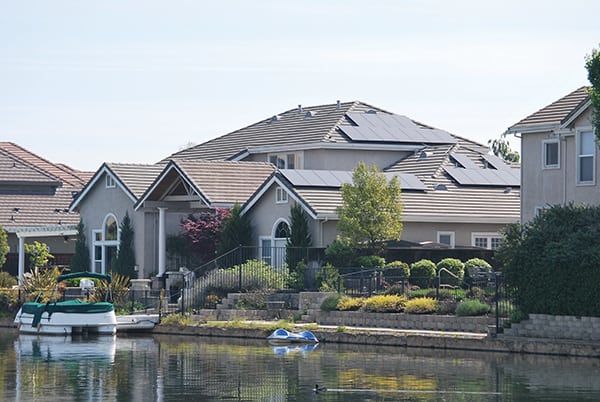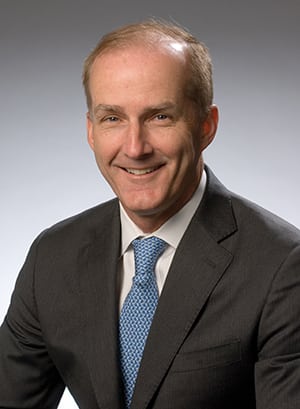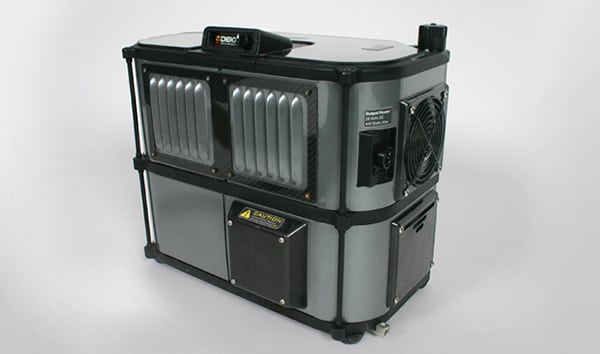David Crane and the Coming Electric Utility Apocalypse
The hyperbole in the headline comes not from the author but from those nipping at the heels of the traditional electric utility industry. Hyperbole aside, several recent and likely future developments have set the stage for a new set of industry players.
Several years ago, Jean and Bob Galey of Catoctin Creek Farm in rural western Maryland installed solar photovoltaic (PV) panels on the south-facing roof of one of their outbuildings. Since then, they’ve generated up to half of the electricity they use on their small sheep farm.
The Galeys have cut their electricity costs even further by taking advantage of Maryland’s net metering program. That allows them to sell excess power that they can’t use to their local electric distribution company, Potomac Edison, a FirstEnergy company. They get paid the full retail rate for the excess electricity they sell to the grid.
This is an increasingly common story. The Galeys are semi-connected to the conventional electric distribution grid, as are hundreds of thousands of other Americans (although a vanishingly small number have chosen to completely disconnect from the utility grid). The Solar Electric Power Association in 2012 estimated that there were some 200,000 rooftop solar customers, with aggregate capacity of around 2,400 MW, in the U.S. The number has certainly grown substantially since then.
Conventional utilities are not happy with these developments. Regulatory battles over the size, scope, and spread of rooftop solar flared up across the U.S. last year. The most prominent conflagrations occurred in Arizona and Colorado, as conventional utilities claimed that they and their completely connected customers were subsidizing the solar, off-grid (or partially off-grid) adventurers (Figure 1).
Although the number of rooftop solar customers today represents only a tiny slice of the customer base of traditional utilities, less than 1%, it presents at least a theoretical threat to the business model. The utilities take that seriously. Some in the industry regard it as an existential threat.
Distributed generation—which in this case refers to generation that is not under the utility’s control—may be a more direct challenge as time goes on. A January 2013 report from the investor-owned utility lobby Edison Electric Institute (EEI), “Disruptive Challenges: Financial Implications and Strategic Responses to a Changing Retail Electric Business,” lays out the case for the angst of utilities: “Recent technological and economic changes are expected to challenge and transform the utility industry. These changes or ‘disruptive challenges’ arise due to a convergence of factors, including: falling costs of distributed generation and other distributive energy resources (DER); an enhanced focus on development of new DER technologies; increasing customer, regulatory, and political interest in demand-side management technologies; government programs to incentivize selected technologies; the declining price of natural gas; slowing economic growth trends; and rising electric prices in certain areas of the country.”
Taken together, says the EEI report, “These factors are potential ‘game changers’ to the U.S. electric utility industry and are likely to dramatically impact customers, employees, investors, and the availability of capital to fund future investment.” That, says the EEI, could spell the end of the electric utility industry as we know it today.
Disruption or Death Spiral?
While the prospect of a disassembled grid appears somewhat farfetched, the electric utility industry is mindful of developments in other industries that, decades ago, looked equally impervious to fundamental change. Says the EEI report, “In the late 1970s, deregulation started to take hold in two industries that share similar characteristics with the electric utility industry—the airline industry and the telecommunications industry.” Both airlines and telecom are capital-intensive. They were price-regulated and largely free of competition, notes the EEI report. Both no longer look as they did when the regulatory winds of change arrived.
Today’s landscape for regulated businesses such as electric utilities looks a lot like that of the dying days of airlines and telecom, notes the EEI report. That scares the heck out of many in the electricity business.
Enter David Crane (see sidebar “Who Is David Crane?”). Crane, 54, is CEO of NRG Energy, one of the earliest and biggest of the non-utility generators, created in the mid-1990s when it became apparent that generation of electricity to supply the transmission and distribution grid was not, as long perceived, a natural monopoly. Indeed, generation was and has become an intensely competitive market. That was a truly disruptive set of circumstances, still sinking in, for the electricity business.
Over the years, NRG has invested billions of dollars in conventional power plants not owned by vertically integrated utilities, selling the power output into merchant markets such as the PJM Interconnection, the Midcontinent Independent System Operator, the California Independent System Operator, the Electric Reliability Council of Texas, and other organized wholesale markets. NRG is also pushing utility-scale merchant solar, as one of the major owners of the new Ivanpah solar power tower in California.
But Crane is looking well beyond the conventional utility paradigm of how to generate, sell, and distribute electricity. He predicts that electricity will go the way of the airlines and telecom in the last century. His predictions—and his company’s investments—have many utilities trembling. Crane wants to take down their businesses, starting from the roofs of their customers’ homes, one roof at a time.
Speaking at a Wall Street Journal conference late last year, Crane said that conventional integrated utilities “realize that distributed solar is a mortal threat to their business.” The problem they face, he explained, is that as the utilities lose customer load, they still face the enormous investments they have made in generation, transmission, and distribution. “They can’t cut costs, so they will try to distribute costs over fewer and fewer customers,” said Crane. Those rate increases will drive more customers away from the integrated utility (or even the distribution utility that buys its power from competitive wholesale suppliers). It could be an economic death spiral.
“Death spiral” is a term that Crane embraces. In an interview in The Atlantic last November, he said, “I completely agree that the distributed future will be utterly destructive of the utility model that we now have. No one wants to spend more on electricity than they have to. If you can monetize the solar value of your own real estate – put solar panels on your roof to produce your own power and do that more cheaply and reliably and add capital appreciation to the value of your own home, why wouldn’t you do that?”
The research investment firm Morningstar earlier this year identified distributed generation as posing the “most significant threat” to conventional electric utilities, although it could be a decade or more before the impact becomes substantial. According to the Morningstar analysis, utilities with big investments in baseload nuclear and coal face the greatest threat.
The Stranded Cost Canard
Harkening back to the days of electric utility restructuring in the mid-to-late 1990s, the specter of distributed generation to utilities is the possibility of “stranded costs,” which the EEI report cites specifically. The EEI report notes that “tariff structures in most states call for non-DER customers to pay for (or absorb) lost revenues. As DER penetration increases, this is a cost-recovery structure that will lead to political pressure to undo these cross subsidies and may result in utility stranded cost exposure.”
A Clemson University website (http:// bit.ly/NseENV) discusses the issue of stranded costs. “The term ‘stranded costs’ has emerged as an issue only in the context of electricity deregulation,” says the Clemson analysis. “It has no roots in economic theory. For instance, there was little or no attention paid to stranded costs in the discussions on airline deregulation, trucking deregulation, and most oddly, the breakup of AT&T.” Yet analysts looking at the potential of distributed electric generation are also citing the experience of the airlines and the telecommunications business.
The Clemson article continues: “What are stranded costs, and why have they received such scant treatment in the economics literature? A general definition is that they are any investment that will be less valuable under competition than under regulation. Two of the academic writers on this topic say that stranded costs are ‘those costs that the utilities are currently permitted to recover through their rates but whose recovery may be impeded or prevented by the advent of competition.’”
Based on its January 2013 “Disruptive Challenges” report, the EEI and its member utilities last year launched a major political campaign with this somewhat-veiled call to action: “Revising utility tariff structures, particularly in states with potential for high DER adoption, to mitigate (or eliminate) cross subsidies and provide proper customer price signals will support economic implementation of DER while limiting stress on non-DER participants and utility finances. This is a near-term, must-consider action by all policy setting industry stakeholders.”
Disputes over DER
In mid-year 2013, the Wall Street Journal reported, “Legislatures in half the states that require electric utilities to buy renewable energy are considering proposals to roll back those mandates.” While most of that activity focused on altering or eliminating state renewable energy purchase mandates, challenges also arose to state net metering programs encouraging rooftop solar and other distributed technologies. Among the states where attacks on net metering occurred: Arizona, California, Colorado, Kansas, North Carolina, and Utah.
The biggest battle came in Arizona. The dominant investor-owned utility, Arizona Public Service, asked the Arizona Corporation Commission (ACC), the state’s utility regulatory agency, to eliminate Arizona’s generous net metering requirement in a state that gets a lot of sunshine year round. The utility said the program was shifting costs to conventional customers, representing a subsidy to well-off rooftop solar customers. The solar industry responded that the utility was juggling its numbers because it feared losing captive customers.
In the middle of the dispute, the Rocky Mountain Institute (RMI) in Colorado weighed in with a useful study, “A Review of Solar PV Benefit & Cost Studies” (http://bit.ly/OuoRuy). The RMI report found a decided lack of data to support either side of the dispute over the effects of net metering. “No study comprehensively evaluated the benefits and costs of distributed photovoltaics, or DPV,” the authors reported, “although many acknowledge additional sources of benefit or cost and many agree on the broad categories of benefit and cost. There is broad recognition that some benefits and costs may be difficult or impossible to quantify, and that some accrue to different stakeholders.”
Ultimately, the Arizona regulators adopted a Solomonic, “split the baby,” solution. By a 3-2 vote, the ACC commissioners imposed a modest 70¢/kW monthly fee on new rooftop solar installations to offset the putative costs to the utility. That amounts to about $4.20/month for the average new installation. The state’s existing 18,000 PV installations would not be affected.
Last year’s skirmishing over the impact of distributed generation may not occur this year. In February, the EEI and the Natural Resources Defense Council (NRDC), a leading national environmental group with a decades-long interest in electricity policy, signed what some have called a “peace treaty” on a number of regulatory issues that have divided the industry and the environmental movement over the years. The agreement encompasses issues such as “decoupling” sales and revenues, real-time pricing, and cost-recovery of smart meters and smart grid technologies.
The EEI-NRDC accord includes a statement on distributed generation. Net metering programs for distributed generation such as rooftop solar, are positive for society, the two groups agreed. But that does not “reduce a grid’s need for central station generation and other infrastructure,” and “typically does not eliminate the owner of the generating assets need for ‘grid services’. For example, solar generation at a residence typically does not align perfectly with the occupants’ energy use, requiring some use of the grid as the equivalent of a battery.”
That may represent a short-term resolution to the tension over distributed generation. But it may not turn out to be significant in the long run.
A Different Sort of Grid
Here’s where NRG’s David Crane comes into the picture again, with a typically disruptive notion. He wants to use the natural gas distribution network to replace reliance on the electric utility grid. Noting that some 34 million American homes have a natural gas line into their home, Crane told The Atlantic, “All we need is a technology that converts that natural gas into electricity in your basement and then solar has the partner it needs for me to tell the owners of the grid to just shove off and disconnect my wire. The day is coming when people are going to be converting natural gas into electricity in their own home.”
To advance that day, NRG is working with Deka Research of Manchester, N.H., a firm headed by legendary inventor Dean Kamen (the father of the Segway and inventor of medical infusion pumps) on a Stirling cycle engine (see sidebar), called the Beacon 10, which can generate up to 15 kW of power. The DEKA Stirling cycle generator is about the size of a home washing machine and is largely silent (as it requires no combustive explosions to generate the movement of a piston to turn a turbine).
NRG’s idea is to integrate the Beacon gas-fired generator with rooftop PV. Crane says that “for the disconnected-from-the-grid home of the future, power first comes from solar on the roof because that’s the lowest marginal cost. The Dean machine also has a battery so you decide how much or little natural gas you want to use. When there’s not enough solar, you turn on the Beacon 10. Then, ideally, the grid itself would just be the ultimate backup. It’s the coolest thing I’ve ever seen.”
As Crane envisions it, the gas-solar system would be leased to customers, using the successful financial model of SolarCity that has helped spread rooftop PV systems across the country. And NRG would also be able to control the machines that it would own. “The way we are envisioning this is that if we had 10,000 of these machines just in the greater New York City area and we as a company had control of the machines,” Crane said, “that becomes a 100-MW peak power plant as well.”
How far into the future is Crane’s vision of the electric utility apocalypse? He says the conventional electric utility business model is about where telephony was in 1985. That was not long after federal Judge Harold Greene signaled the end of the long-distance, fixed land-line monopoly of AT&T, widely known, sometimes affectionately and sometimes not, as “Ma Bell.”
As part of his order breaking up the AT&T land-line monopoly, Greene offered AT&T control over the nascent cell phone business. Ma Bell, figuring that cell phones were a fad, declined the offer. Instead, the business went to Seattle entrepreneur Craig McCaw and his company, McCaw Cellular, for a pittance. Less than 10 years later, McCaw sold the business to AT&T for over $11 billion. Now, land lines are an anachronism and cell phones are ubiquitous.
“Let’s just call it game over, cell phones won,” Crane said. “But it took 25 years.” ■
— Kennedy Maize is a POWER contributing editor and blogger at powermag.com/blog.


